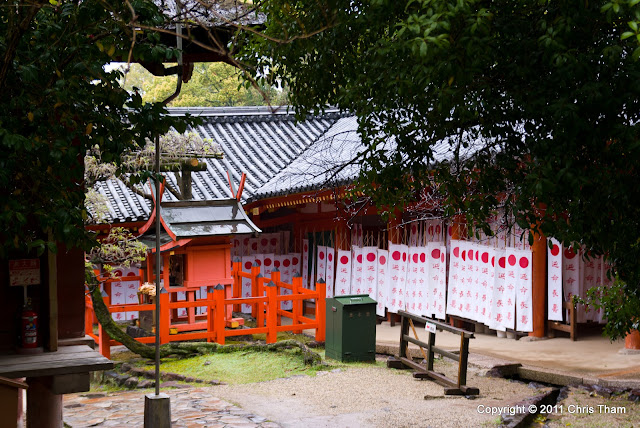The Kasuga Grand Shrine (春日大社), originally the family shrine of the once powerful Fujiwara family, is the largest and most extensive shrine in Nara. Founded over 1,200 years ago, it is now a UNESCO World Heritage site.
We visited by walking south from the Tamukeyama Hachimangu Shrine. On the way, we passsed through these set of steps with some old shops on either side:
And managed to attract the attention of yet another deer:
There's an old noodle shop on the path to the Kasuga shrine:
A small but bubbly stream runs along next to this shop:
Before we reached the main area of the shrine, we passed through a number of auxiliary shrines attached to the area. The first, appropriately located next to the stream is the Mizuya auxiliary shrine (摂社水谷神社) - which is used to worship gods/goddesses associated with water:
After that, we passed through a path full of stone lanterns:
Next we encountered water gushing out of a spring next to the walls of main compound:
The next auxiliary shrine we saw is the Hitokotonushi Shrine (一言主神社). Hitokotonushi is "The God of One Word" - apparently he only grants requests to prayers consisting of only one word, and similarly his answers to questions will only consist of one word:
Next is the Souguu Shrine (総宮神社), associated with worship of the Sun God:
This is a prayer hall - Kitoujo (祈祷所):
And this is an Ancestral ceremonial hall (先祖斎場):
This is also another prayer hall:
This is the Keishouden (桂昌殿):
Sakadono (酒殿):
Hetsuidono (竃殿):
Entrace to the Keiga Gate (慶賀門):
Inside there is a huge wisteria tree, supported by trellis:
And a very picturesque row of copper lanterns:
These are the Heiden and Buden (幣殿・舞殿), or the halls of cut paper chains and fans:
We saw some schoolchildren on a field trip - apparently their assignment is to practice their English by interviewing foreigners, because I noticed they targeted anyone looking vaguely Western and started asking questions from a piece of paper! Unfortunately it seems there were quite a few non-English speaking foreigners which stumped some of the children.
The ticket office to see the inner compound:
You can also buy deer fortunes here (鹿みくじ):
The tree on the right is a sacred apple tree:
And this is the accompanying apple tree sand garden - Oosugi shatou (社頭の大杉):
The inner gate (中門):
Two nice copper lanterns next to the Orou (御廊):
Some of the many shrines here:
The corridors are lined with copper lanterns:
Another deer grazing on the grounds:
There are four deities worshipped here - each shrine belongs to a specific deity:
The Treasure House (宝庫):
A beautiful gold plated lantern:
Gold and copper lanterns:
The lanterns are also called Fujinaminoya (藤浪之屋):
The Tsubakimoto shrine (椿本):
The Taga shrine (多賀神社):
Inside the Naoraiden (直会殿):
The Nejirou (捻廊):
A woman doing calligraphy:
The beautiful South Gate (南門):
Further South from the South Gate is are paths full of stone lanterns and no less than 12 shrines representing ancestors of the Fujiwara family:
These stone lanterns are called Oaigatadourou (御間型灯籠):
And the path through them is called Oaimichi (御間道):
The first of the 12 shrines - Honguujinjayouhaisho (本宮神社遙拝所):
The Wakamiya Shrine (若宮神社):
More shrines:
The Meotodaikokusha (夫婦大國社):
Even more shrines:
The Kiijinja (紀伊神社):
The Kaguraden (神楽殿):
This large tree is sacred and called the Ookusu (大楠):
Leaving the Shrine ...
Passing back through the stream:
Passing through a wooded area:
We saw this rickshaw:
This is the Garden of Kasuga Taisha Shrine (春日大社神苑):
And finally back to Nara Park:















































































































No comments:
Post a Comment